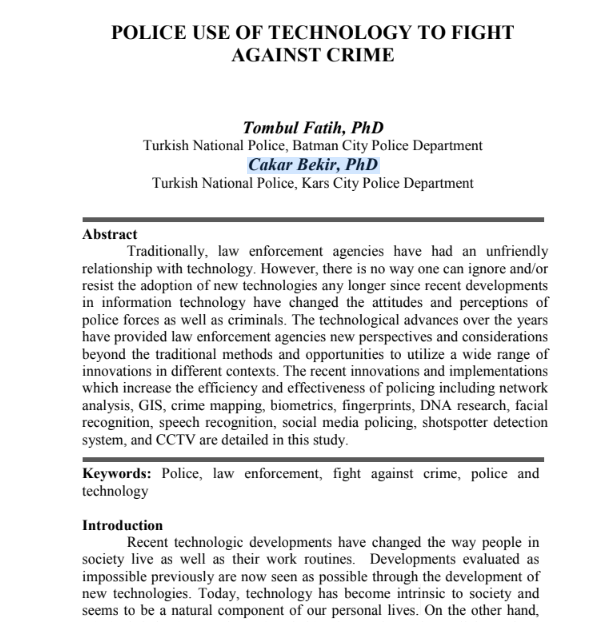POLICE USE OF TECHNOLOGY TO FIGHT AGAINST CRIME by Tombul Fatih, PhD and Cakar Bekir, PhD

| Title | POLICE USE OF TECHNOLOGY TO FIGHT AGAINST CRIME by Tombul Fatih, PhD and Cakar Bekir, PhD |
| Author | Tombul Fatih, PhD- Turkish National Police, Batman City Police Department Cakar Bekir, PhD- Turkish National Police, Kars City Police Department |
| Overview | Overview of “Police Use of Technology to Fight Against Crime” by Tombul Fatih, PhD, and Cakar Bekir, PhD The article “Police Use of Technology to Fight Against Crime” by Tombul Fatih and Cakar Bekir provides an in-depth analysis of how law enforcement agencies are increasingly adopting advanced technologies to enhance their ability to combat crime. The authors begin by discussing how technological advancements have changed the way society operates and how these developments have impacted both criminals and law enforcement. While criminals have leveraged technology to commit more sophisticated crimes, law enforcement agencies have also recognized the need to modernize their tools and approaches to keep up with these changes. The introduction sets the stage for the discussion by outlining the traditional reluctance of law enforcement to embrace new technologies. However, the article emphasizes that this reluctance is no longer viable in the face of the rapid technological evolution in recent years. Technology has become deeply embedded in daily life, and it has transformed the ways in which both police and criminals operate. Criminals now use advanced software and hardware to commit crimes, which has made these offenses harder to detect using traditional policing methods. As a result, law enforcement agencies are compelled to adopt new strategies and tools to address these challenges. One of the central arguments in the article is the importance of information technology (IT) in modern policing. The authors highlight that law enforcement agencies have increasingly utilized IT for various tasks, including general administrative work and core policing activities such as crime prevention and investigation. These agencies now rely on technologies such as Geographic Information Systems (GIS), crime mapping, biometric identification, and facial and speech recognition to fight crime more effectively. The article explains that these technologies provide law enforcement with the ability to analyze data, detect crime patterns, and even predict potential criminal activity. However, the authors acknowledge that the adoption of technology by law enforcement agencies is not without challenges. One significant issue is the resistance to change within police organizations, which can hinder the effective implementation of new technologies. Some law enforcement professionals and managers are reluctant to integrate IT into their daily operations, which limits the potential benefits of these tools. Moreover, the article discusses the difficulties associated with training officers to use new technologies and the need for police forces to adapt their routines to align with technological innovations. The article also examines the different types of crimes that law enforcement agencies deal with, ranging from major offenses such as murder and armed robbery to volume crimes like shoplifting and burglary. According to the authors, technology plays a crucial role in solving these crimes, particularly when it comes to identifying serial offenders. Police forces now employ crime analysts who specialize in using IT to find connections between different crimes and to uncover trends that can lead to the identification and capture of criminals. Public expectations of law enforcement have also evolved, with communities demanding that police agencies utilize advanced technologies to protect citizens and solve crimes. The authors emphasize that police departments are responsible for safeguarding sensitive personal information and ensuring that their data management systems are secure. This is a complex task, as it requires law enforcement agencies to legally manage large quantities of data while maintaining the integrity of their databases. The article also touches on studies that have explored the relationship between IT and police performance. One such study, by Garicano and Heaton, revealed that while there is no direct link between general IT usage and crime reduction, the productivity of police agencies increases as they adopt more IT tools. The authors also reference Colvin and Goh, who found that the quality and timeliness of information are key factors that influence police officers’ acceptance of new technologies. Additionally, the article highlights the importance of knowledge management within law enforcement agencies. The authors argue that law enforcement organizations need to invest in knowledge management systems to ensure that they can process and analyze vast amounts of data efficiently. This, they suggest, is crucial for developing a learning organization that can adapt to new challenges and make informed decisions based on the latest available information. In conclusion, the article asserts that technology is indispensable for modern policing. The authors argue that law enforcement agencies must continue to adopt new technologies to stay ahead of criminals who are using increasingly sophisticated methods to commit crimes. The integration of IT into policing strategies is vital for improving crime prevention, enhancing investigation processes, and ultimately providing better protection to the public. |
| Download Link | click here to download |